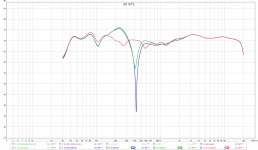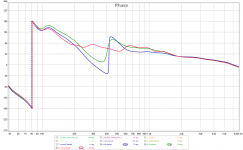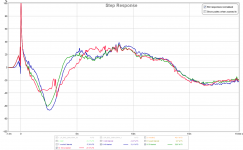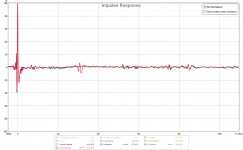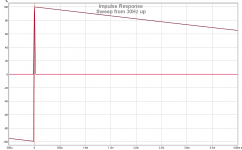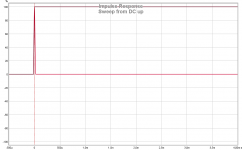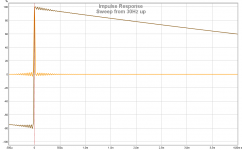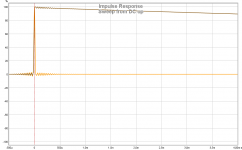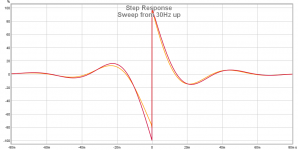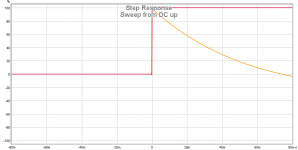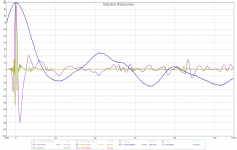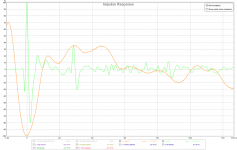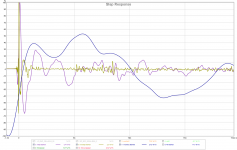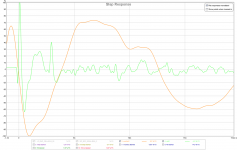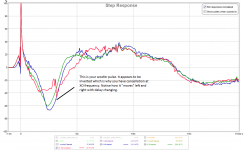Previous graphs were with 15sample window, going down to 4 doesn't seem to change much:
Measurement setup:
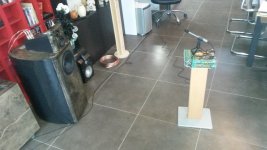
Target curves
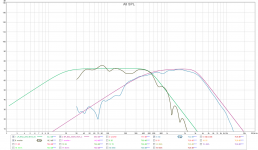
26S delay
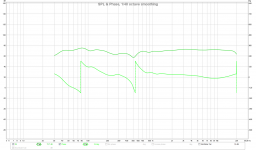
50S delay woofer positive
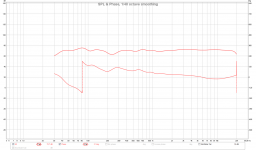
50S delay woofer negative
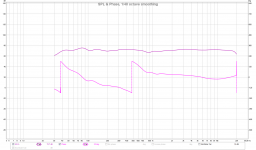
Seems a bit weird since the mid-tweet integration went very well and measurements look very very similar to predicted simulation
Measurement setup:

Target curves

26S delay

50S delay woofer positive

50S delay woofer negative

Seems a bit weird since the mid-tweet integration went very well and measurements look very very similar to predicted simulation
I like the red one, 50S delay. For this to work all drivers should have positive connection.
Phase seems to be quite flat over a large area. How does that one sound?
Do you use auto EQ in REW? or massage it into shape by hand. The better you hit the target at 4 cycles, the better the combined STEP should measure. Can you show the (combined) STEP from that 50S version?
It actually looks pretty good to me, don't fear the dotted line at 80 Hz, it's not a phase wrap, phase just moved past 180 degree and the plot continues at the bottom.
Phase seems to be quite flat over a large area. How does that one sound?
Do you use auto EQ in REW? or massage it into shape by hand. The better you hit the target at 4 cycles, the better the combined STEP should measure. Can you show the (combined) STEP from that 50S version?
It actually looks pretty good to me, don't fear the dotted line at 80 Hz, it's not a phase wrap, phase just moved past 180 degree and the plot continues at the bottom.
Last edited:
Can you give me what your delays are in milliseconds? I don't know what your sample rate is. Also the Harsch XO needs a 1.00ms delay of the mid/tweeter combo relative to the woofer for 500Hz XO, not including offset of woofer. Assuming the woofer has a circa 25mm offset (typical for 8in woofer on flat baffle) the delay needs to be 1.00ms minus time of flight for 25mm. Or 1000us minus 74us or 926us. Assuming 48000 samples per second this is equal to 44.5 cycles of delay. So to get exact, step up and down in 1 cycle steps and look at Step Reaponse for best shape.
One other suggestion is to move mic closer so that it is less than distance that would allow a floor bounce to happen before your window. I use 0.5m for setting the delays and find that translates well when I listen farther away where reflections do happen.
One other suggestion is to move mic closer so that it is less than distance that would allow a floor bounce to happen before your window. I use 0.5m for setting the delays and find that translates well when I listen farther away where reflections do happen.
One other suggestion is to move mic closer so that it is less than distance that would allow a floor bounce to happen before your window. I use 0.5m for setting the delays and find that translates well when I listen farther away where reflections do happen.
Though wile designing it can bring clarity to the measurements, you got to remember the relative distances change at the listening position and it would be wise to check/adjust for the final setup i.m.h.o. No way around the room influence there though, without some work with damping/diffracting.
Great looking speaker speaker : )
Comment try start of sweep much lower than 30Hz, from DC guess should be fine when XO is turned on.
Comment try start of sweep much lower than 30Hz, from DC guess should be fine when XO is turned on.
Comparing the 15 cycle gate with the 4 cycle does show something at 200 Hz is messing up the woofer response. But I'm still anxious to see the combined step and impulse you get with that 50S version.
Samplerate is 48kHz at the moment, Najda can do 96 and 192 also should I need better resolution (have never used it yet)
I used 4 sample window this time
Okay so first better target curves:
Before
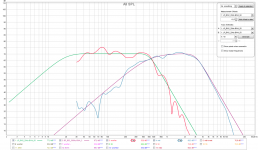
After
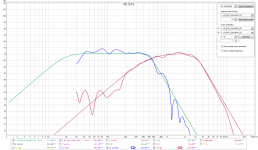
Then I measured delays from 35 samples till 50 samples all still 1 meter on axis tweeter height. (I can do 50cm later)
SPL
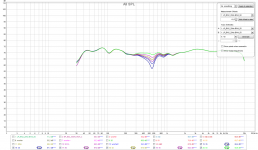
Phase
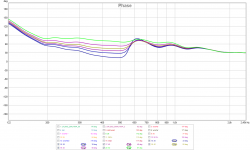
STEP
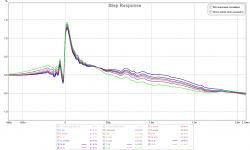
The 50S (~1ms delay) has nice phase and SPL like predicted in simulation. I'm just wondering why the STEP is off so much.
I used 4 sample window this time
Okay so first better target curves:
Before

After

Then I measured delays from 35 samples till 50 samples all still 1 meter on axis tweeter height. (I can do 50cm later)
SPL

Phase

STEP

The 50S (~1ms delay) has nice phase and SPL like predicted in simulation. I'm just wondering why the STEP is off so much.
Last edited:
I like the first purple one under the green. The tell tale of a Harsch working is a slightly lower sum response that is a bit lower than plain woofer. The step looks good but I am perplexed why it only goes to 500us. Should be circa 3ms or more.
Also, there is something strange at the leading edge - you have a small sharp rise then it drops and rises again. This may make the sharp attack diffuse and reduxe impact of the Harsch XO. Is that a DSP pre-ringing? I see a slight shoulder rise on the leading edge on mine but no double peak like this.
Also, there is something strange at the leading edge - you have a small sharp rise then it drops and rises again. This may make the sharp attack diffuse and reduxe impact of the Harsch XO. Is that a DSP pre-ringing? I see a slight shoulder rise on the leading edge on mine but no double peak like this.
Last edited:
All of the separate STEP results (woofer, mid, tweeter) show something similar judging this earlier example:
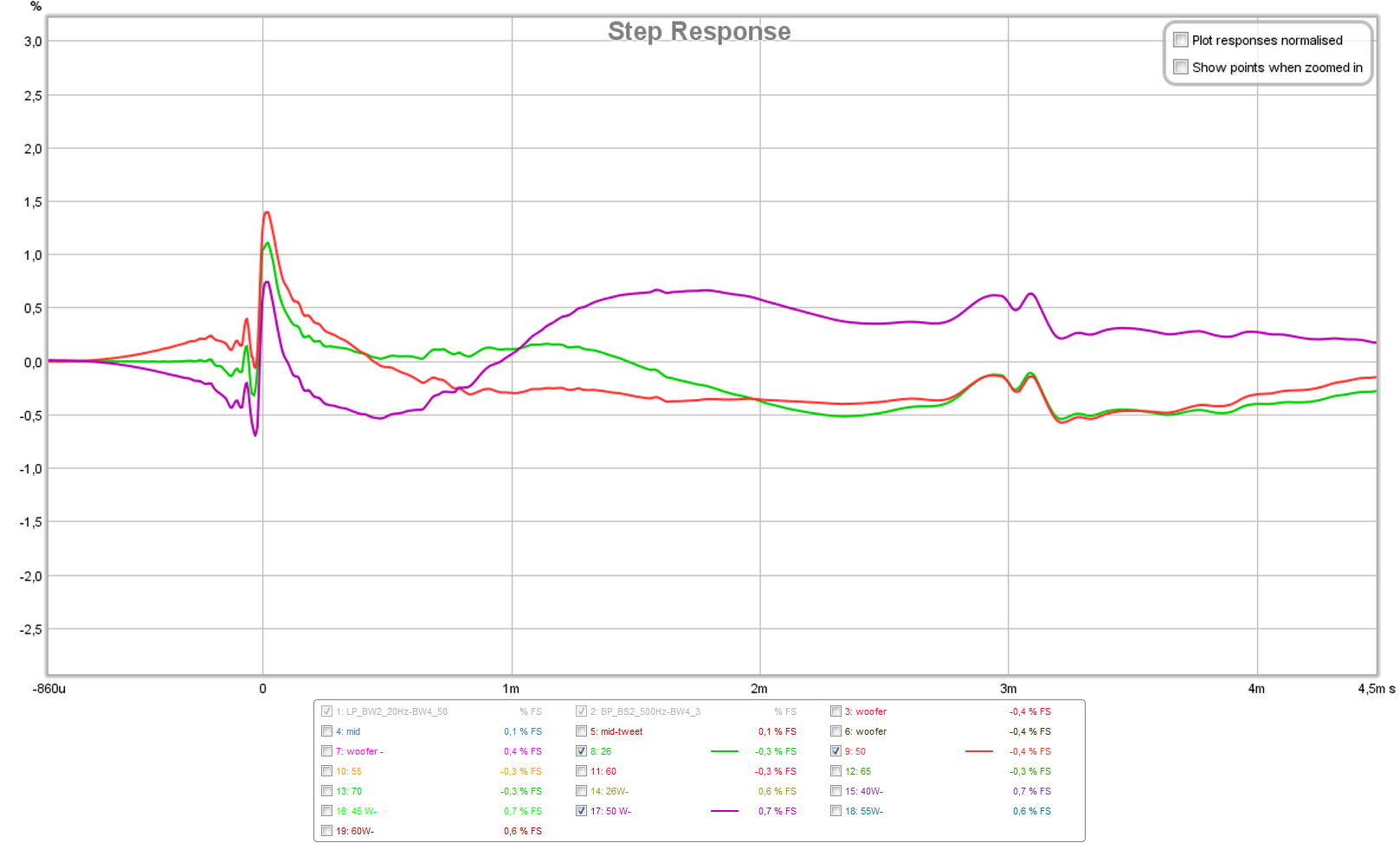
Shouldn't be a DSP thing but something is up. Maybe a regular impulse shows more info?
I think something is happening to the woofer response at 200 Hz preventing it from following the desired shape.
A regular impulse zoomed out to ~10 ms should show it. Somewhere around 5 ms there should be something happening...

Shouldn't be a DSP thing but something is up. Maybe a regular impulse shows more info?
I think something is happening to the woofer response at 200 Hz preventing it from following the desired shape.
A regular impulse zoomed out to ~10 ms should show it. Somewhere around 5 ms there should be something happening...
Last edited:
.....I'm just wondering why the STEP is off so much.
Yes and why is step not up to around 100% but instead show less than 1,5%.
Can you show IR/SR for each of the pass band, by that we can see for sure polarity if it goes up or down for all three. If those are alright i would only sum woofer and mid until IR/SR look close to picture 4 post 171, then do the same for mid and tweeter as in picture 5. By that offset settings should be revealed and then sum all three.
Thanks sharing.
So I added a bunch of blankets and some polyestermat between speaker and mic (it's about 30cm thick) and did some measurements between 40 and 50 sample delay.
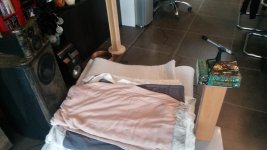
SPL
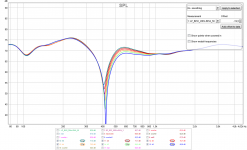
Phase
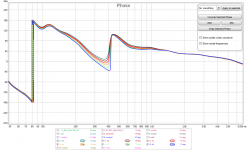
STEP zoom out from before using the blankets (this is a zoom out of the step in my previous post)
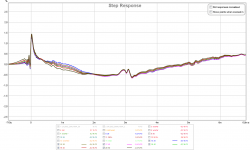
Step with blankets
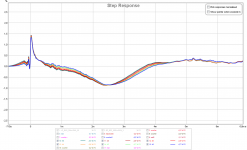
Step with blankets
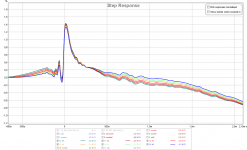

SPL

Phase

STEP zoom out from before using the blankets (this is a zoom out of the step in my previous post)

Step with blankets

Step with blankets

Nice to see blankets have an effect. Please show IR and SR on same plot.
It is odd that as you vary delay, I don't see the leading pulse separating in time delay from the bigger tail. This tells me your delay is completely off - you are missing the big woofer pulse altogether. You should see a sharp spike "move" left and right relative to a broad but gentle "hill" that represents the woofer step. I don't see that happening so I assume your woofer pulse is somewhere to the right of the plots. Maybe expand horiz time axis...
Actually, looking at the deep cancellaton null at XO, is that because you flipped polarity to show your XO frequency?
It is odd that as you vary delay, I don't see the leading pulse separating in time delay from the bigger tail. This tells me your delay is completely off - you are missing the big woofer pulse altogether. You should see a sharp spike "move" left and right relative to a broad but gentle "hill" that represents the woofer step. I don't see that happening so I assume your woofer pulse is somewhere to the right of the plots. Maybe expand horiz time axis...
Actually, looking at the deep cancellaton null at XO, is that because you flipped polarity to show your XO frequency?
Last edited:
I did not change polarity, I checked, rechecked and remeasured, that is what it is. I'll take the blankets away between 2 measurements to be 100% sure.
Last edited:
Ahh... it is more clear now. Your woofer is inverted for whatever reason. Flip polarity on woofer so it pushes out with positive going tweeter and mid. Also, add about 2.2ms of delay to your mid and tweet combo and it should line up with woofer leading edge. Start there and adjust delays by little steps to get best response in SR shape. Don't know what it is but there is a significant delay in your woofer response relative to the rest of the system.
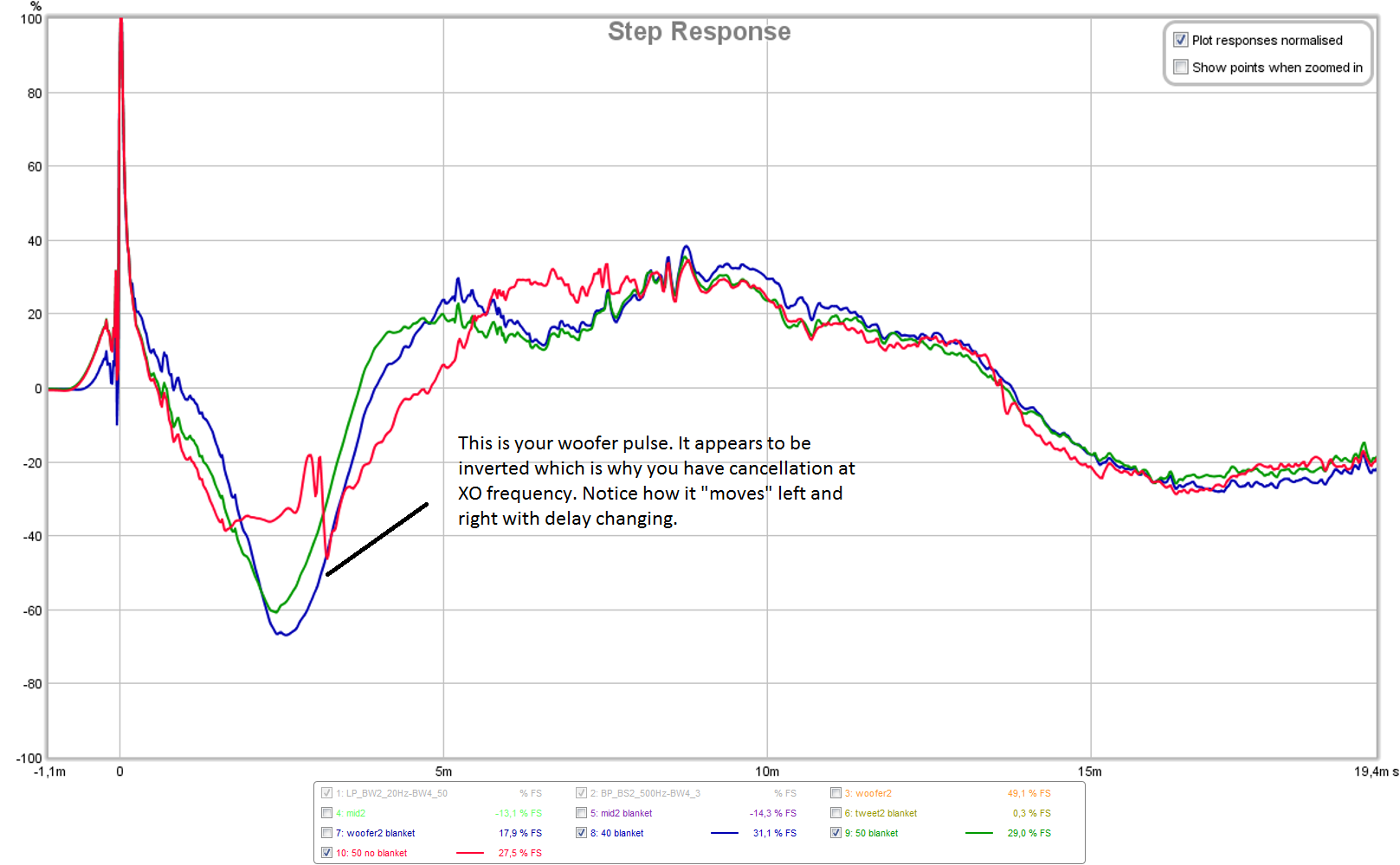
Hope that helps.

Hope that helps.
Attachments
But still every impulse has that pre-pulse present. Warning you the big pulse is coming. I do wonder what's up with that. Is this an USB dac?
So, if I'm understanding everything correctly, my woofer is inverted and I was never able to see this in any measurement because the floor bounce masked it completely? I'm having a hard time grasping this but I will redo the measurements for the woofer inverted with blankets.
I did do a measurement series with the woofer inverted (without blankets) now with a 4 sample window:
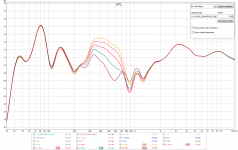
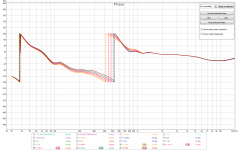
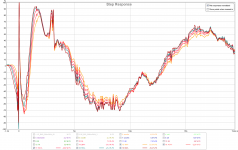
Delays from 40samples to 60 samples but there is always phase-wrap AND the pre-rise goes down instead of up
Complete description of system:
analogue out on pc soundcard to denon AVR3806 DVD-in (Audissey off)
Denon AVR3806 pre-out to Najda analogue in
Najda internal DAC
Najda analogue out to amps (sony FE520R for tweet, phillips FA880 for mid, NAD 356BEE for woofer)
Interlinks between Najda and amps are identical, no ridiculously long speaker cables
I like to keep the Denon in the system when measuring because 99% of the time I'm listening from HTPC via HDMI to Denon, it also does the crossover to the sub (I do put the crossover at 40Hz instead of 80 when measuring and keep the sub off)
I did do a measurement series with the woofer inverted (without blankets) now with a 4 sample window:



Delays from 40samples to 60 samples but there is always phase-wrap AND the pre-rise goes down instead of up
Complete description of system:
analogue out on pc soundcard to denon AVR3806 DVD-in (Audissey off)
Denon AVR3806 pre-out to Najda analogue in
Najda internal DAC
Najda analogue out to amps (sony FE520R for tweet, phillips FA880 for mid, NAD 356BEE for woofer)
Interlinks between Najda and amps are identical, no ridiculously long speaker cables
I like to keep the Denon in the system when measuring because 99% of the time I'm listening from HTPC via HDMI to Denon, it also does the crossover to the sub (I do put the crossover at 40Hz instead of 80 when measuring and keep the sub off)
Last edited:
Yes, your woofer is definitely inverted previously and correct polarity here:
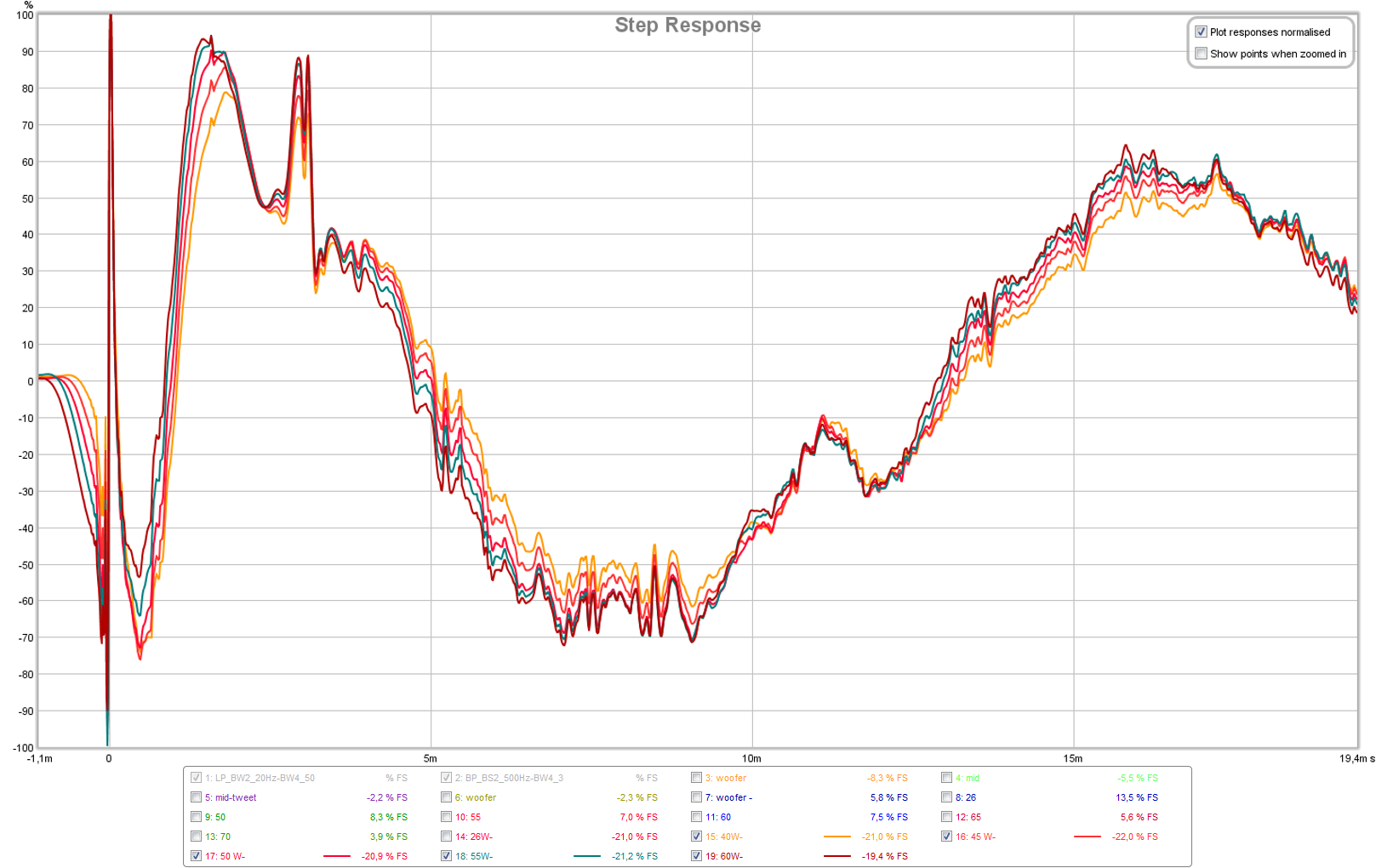
Add the 2.5ms or so of delay to mid and tweeter and you will hear a significant improvement in the snaps of drums or articulation of plucked bass and piano.
Phase wrap is probably floor bounce and will go away when at 0.5m and 5ms gate.

Add the 2.5ms or so of delay to mid and tweeter and you will hear a significant improvement in the snaps of drums or articulation of plucked bass and piano.
Phase wrap is probably floor bounce and will go away when at 0.5m and 5ms gate.
- Home
- Loudspeakers
- Multi-Way
- S. Harsch XO
